Honda’s New Subcompact an Even Better Fit
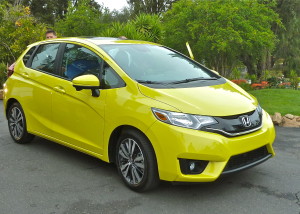
For 2015, Honda redesigned the subcompact Fit from top to bottom, with more room, power, gas mileage.
By John Gilbert
Other than the engine, transmission, suspension, steering, safety technology, platform, exterior body panels, interior room and design, and latest safety and connectivity technology, there isn’t really that much that’s new about the 2015 Honda Fit.
It’s still got the same old name.
Of course, even there Honda has a winner, because Fit was the perfect name when the popular subcompact was first introduced and revised for a second generation. Starting under $20,000, the versatility of the Fit handled whatever you were doing, whether climbing aboard to drive or ride, stashing groceries under the hatchback, or folding the rear seats flat for extra storage, everything in the car…fit!
It’s risky to start redesigning an iconic car like the Fit, which is just as impressive among subcompacts as the Civic is among compacts or the Accord is among midsize cars. But in the case of the third-generation Fit for 2015, Honda has worked its magic to take a car that functioned so well in every way and improve it in every way.
My reservations about the first Fit, which made its debut in 2006, and the second-generation car as well, was that Honda seemed content to reach 30 miles per gallon with the car and its 1500 cc. engine. Honda, Toyota, Nissan, Mazda, Subaru and Mitsubishi, in my opinion, seemed to create a Japanese manufacturer’s united front that 30 mpg was good enough, so they stuck with it. German manufacturers, and then the South Korean breakthrough by Hyundai and partner Kia, proved “40 is the new 30,” and the Japanese were suddenly scrambling to catch up. Mazda was first, with the Skyactiv technology on its 2.0 and 2.5-liter engines. Honda followed by impressively redoing the 2.4-liter 4-cylinder for the Accord.
It was, therefore, with great anticipation that I attended the automotive media introduction of the 2015 Fit, in San Diego. We were stationed at the trendy Andaz Hotel, and our choreographed destination was to drive through the mountains to the Mount Woodson Castle.
The most recent Honda Fit I’d had for a week’s test remained fresh for comparison: At 70 mph, the little single-overhead-camshaft engine was turning 3,000 RPMs through fifth gear of its 5-speed transmission, a high rev reading that resulted in 31 mpg. That was OK, but just OK for a subcompact. I figured a lot of revs were being wasted in fifth, doing the comparatively simple task of maintaining cruising speed.
The new third-generation Fit is on an entirely new platform, with more dramatic styling and with its 1.5-liter 4-cylinder drivetrain revised to come under Honda’s “EarthDreams” scheme. The new engine has 130 horsepower (up from 117) and 114 foot-pounds of torque (up from 106), and three significant upgrades are: dual overhead cams (one for intake valves, the other for exhaust), direct injection, and a 6-speed manual transmission plus an upgraded continuously-variable automatic transmission (CVT).
The CVT adds steering-wheel paddles when you move up from the LX to the EX model, which also gets you 16-inch wheels, a moonroof, push-button start, lane-watch when you signal for a right turn, and a 7-inch screen rather than the basic 5-inch to display connective and internet features. The driver can shift the CVT by choosing D-Range downshifts which return to normal automatically, or an S-Range for almost-manual-feeling ratio adjustments that equate to a 7-speed, and requires the driver to execute ratio changes by paddle-shifting.
My partner and I eagerly set off charging through the Southern California mountains’ most engaging curvy roads, pushing the stick-shift Fit to sports-car-like extremes. On our return trip, mostly on freeways, we cruised along at normal traffic-flow speeds. At that point, I noticed that at 70 mph, our car was turning 3,000 RPMs — same as its predecessor! We both expressed surprise and concern about that, but when we got back to the hotel, I clicked over the computer screen and saw our gas mileage readout as “41.1 mpg.” That was for driving through city traffic, really hard up and down the mountains, and finally cruising back.
Adding an overhead cam, more power and sixth gear should bolster performance, but shouldn’t necessarily improve fuel economy that much. Maybe that’s what they mean by “earth dreams.” Honda officials said that improved engine and transmission technology, plus using 27 percent ultra-high-grade steel helped increase torsional rigidity 15-percent in the car itself could account for the mileage increase. The EX model shows EPA estimates of 29 city and 37 highway with the stick and 33/41 for the CVT. The LX adds underbody panels for aerodynamics and boasts 25/41 EPA figures.
The new Fit comes in a basic LX model that starts at $15,525 ($16,325 with the CVT) and should account for 35 percent of sales; the fancier EX, starting at $17,435 ($18,235 with CVT) and aims at 55 percent anticipated sales; EX-L, starting at $19,800 in CVT only, and which is the EX with added leather and connectivity features aiming for 6 percent; and the EX-L Navi, based at $20,800 and shooting for 4 percent, which adds the navigation system.
Hiroaki Hamaya, the engineer charged with overall product planning for the new Fit, said that the LX has more than $1,000-worth of new features but costs only $106 more, while the top level EX has $1,800 in new features and costs only $250 more. “More buyers are moving up to the LX and EX,” Hamaya said. That figures, with all the added features of the upgrades. But the most significant improvements are very Honda-like refinements. Along with making all its elements lighter and stronger, the CVT has 14 percent wider ratios to make it far more enjoyable than most CVTs, which drone there presence to you in boring monotone. The engine’s direct injection has a side intake that creates a high-tumble fuel-air flow for better burning.
The reason the Fit felt better as we were flinging it around some mountain roadways is that the power increase is complemented by the suspension, which has been improved for angle and material in the front struts, and H-type torsion beams at the rear for improved stability and a more rigid feeling. Electrically boosted steering benefits by a quicker ratio. With vehicle stability assist, hill-hold assist, and torque-correction steering, the lighter but stiffer Fit body is quieter and firmer feeling.
Also, it should come as no surprise that packaging-master Honda has actually worked more magic. It shortened the Fit by 1.6 inches, to 160 inches in overall length, but increased all the interior dimensions for occupants.
Lengthening the wheelbase by 1.2 inches to 99.6 helped, but interior passenger volume is increased by 4.9 cubic inches, with front shoulder room increased by 2.1 inches, and — get this — rear seat legroom increased by 4.8 inches.
That aids Honda’s claim of class-leading cargo capacity, against such notables as the Ford Fiesta, Nissan Versa, Hyundai Accent, and Kia Rio, Toyota Yaris, Mazda2, Chevrolet Sonic, and Kia Soul — all worthy competitors. In fact, it might be the considerable improvement of those competitors that helped motivate Honda to make sure the third-generation 2015 Fit would accept the challenges of making the car look better, ride better, handle better, accommodate people and cargo with more room, and quietly and forcefully improve power and fuel economy. Typically, it Fits right in.


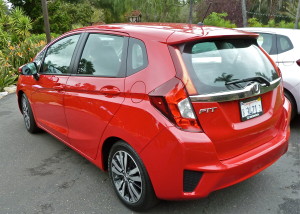
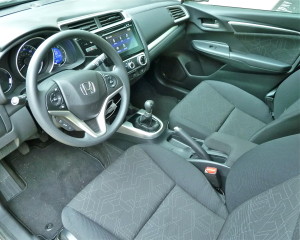
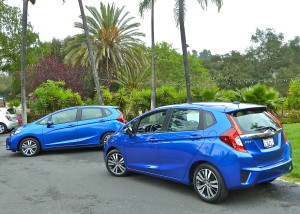
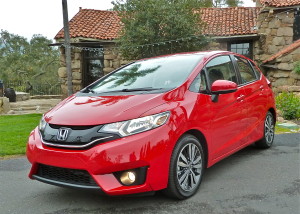
 John Gilbert is a lifetime Minnesotan and career journalist, specializing in cars and sports during and since spending 30 years at the Minneapolis Tribune, now the Star Tribune. More recently, he has continued translating the high-tech world of autos and sharing his passionate insights as a freelance writer/photographer/broadcaster. A member of the prestigious North American Car and Truck of the Year jury since 1993. John can be heard Monday-Friday from 9-11am on 610 KDAL(www.kdal610.com) on the "John Gilbert Show," and writes a column in the Duluth Reader.
John Gilbert is a lifetime Minnesotan and career journalist, specializing in cars and sports during and since spending 30 years at the Minneapolis Tribune, now the Star Tribune. More recently, he has continued translating the high-tech world of autos and sharing his passionate insights as a freelance writer/photographer/broadcaster. A member of the prestigious North American Car and Truck of the Year jury since 1993. John can be heard Monday-Friday from 9-11am on 610 KDAL(www.kdal610.com) on the "John Gilbert Show," and writes a column in the Duluth Reader.